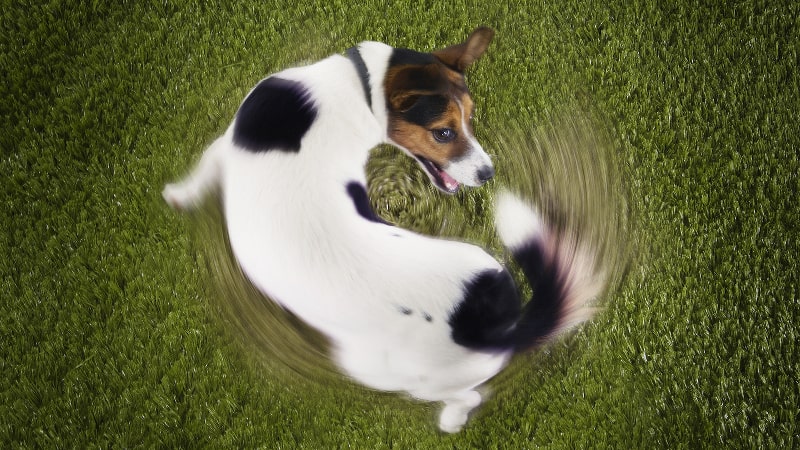
Let’s be honest, watching your dog spin around in hot pursuit of his own tail isn’t one of the proudest moments of pet ownership.
I mean, does your dog really think he’s going to catch that thing if he just gives it a few more whirls? At times like this, you just have to chuckle, shake your head, and hope there aren’t any cat people around to witness this undignified spectacle.
Well don’t be too hard on your dog – there’s a lot more to tail chasing than meets the eye. This behavior begins in puppyhood and may reemerge in an adult dog for various reasons, some of which are the subject of serious research.
In other words, what might seem like sheer canine goofiness could actually have a physical or psychological basis.
The Chase Begins
While tail-chasing in older dogs can be mystifying, it’s pretty easy to understand why puppies do it. Just put yourself in their adorable little paws for a moment.
As a puppy, all of your time is spent with your litter mates sleeping, eating, and playing. The tails you encounter all belong to your brothers, sisters, or Mom, and they’re fun because they move a lot and are easy to chomp.
In other words, for a puppy who is still with the litter or has recently left, a tail is something other dogs have. In fact, it’s debatable whether a dog at this age would even consider whether the tail is part of another animal. To them, it’s just an ever-present toy that repeatedly triggers their prey instinct.
Thus you can easily see why a puppy, on spotting his own tail, might spring into action. As dogs get older, smarter, and more separated from the pack, they no longer fall for this trick of nature. Usually.
Why Adult Dogs Chase Their Tails
Of course, grownup dogs do sometimes whirl around trying to bite their tails – stopping only when they become tired, get dizzy, or in some cases, actually succeed in catching their “prey.”
Any dog is apt to do this once in awhile, but for some, it becomes an obsession. Here are some of the potential causes of it:
Prey Drive. Dog owners know that when something runs, dogs have an almost overwhelming urge to go after it. For many dogs, it might be a matter of catching just the right glimpse of their tail that, for whatever reason, triggers this hardwired instinct. This seems like a good explanation for dogs who only occasionally chase their tails.
Reinforced Behavior. Along with chasing stuff, dogs are also good at learning how to get humans to do what they want. In short, if you laugh or shower your dog with attention when he whirls, he’s likely to do it again… and again… and again…
Compulsive Disorder. Whether it’s due to stress or some deep-seated psychological problem, some dogs are prone to compulsive behavior. Often it’s a comforting or pleasurable activity like humping. Regardless of whether tail-chasing has some special appeal (reversion to puppyhood, perhaps?), it’s the sort of thing a lot of compulsive dogs seem to do.
Boredom. A lot of dog trainers and other canine behavioral experts point to simple boredom as a reason dogs chase their tails. With too much energy and not enough stimulation, dogs create their own entertainment using their own bodies as a “toy.”
Physical Discomfort. Many of the other possibilities here are speculative – this one’s a fact. Dogs suffering pain or irritation often chase their tails in a (usually futile) attempt to get to the problem area. The issue could be anything from a temporary itch to a serious condition that requires treatment.
Other Reasons. Tail-chasing in dogs has been linked to particular breeds (Bull Terriers and German Shepherds, to name two), vitamin deficiencies, shyness, and unneutered females. Who knows how it all fits together. There’s still a lot of research to be done.
When it Becomes a Problem
Other than giving cat lovers ammo, occasional tail chasing in dogs is nothing to worry about. It’s when it becomes an unhealthy habit that it’s time to step in and change the behavior.
Obviously, the first thing you’ll want to do is rule out a physical problem. If there are other symptoms along with the tail-chasing, then this could well be the answer.
But don’t rely on your own examination or, worse, advice on the internet. Chat with your vet to get an informed opinion.
If it’s purely a behavioral issue, you can employ the “usual” dog training solutions. You can try interrupting the behavior by giving your dog a command, or simply ignoring it.
Scolding your dog isn’t a good idea and could easily backfire, especially if the dog is whirling to get your attention (bad attention is still attention) or due to stress (scolding = more stress).
